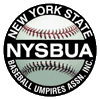Rule 6-1-3: Clarified the correct and legal position of the pivot foot in the set position.
ART. 3 . . . For the set position the pitcher shall have the ball in either his gloved hand or pitching hand. His pitching hand shall be down at his side or behind his back. Before starting the delivery, he shall stand with his entire non-pivot foot in front of a line extending through the front edge of the pitcher’s plate and with his entire pivot foot in contact with or directly in front of and parallel to the pitcher’s plate...any other infielder.
Rationale: To eliminate any confusion or circumvention of the set position pitching rule by a pitcher or coach. Also, to emphasize the pivot foot requirement to be in a legal set position.
Rule 7-3-5c: Clarified the rules for a specific type of interference by the batter.
ART. 5 . . .Interfere with the catcher’s fielding or throwing by:
a) Unchanged language.
b) Unchanged language.
c) Making any other movement, including backswing interference, which hinders action at home plate or the catcher’s attempt to play on a runner, or
d) Unchanged language.
Rationale: Current rule does not address this specific type of interference.
Points of Emphasis
1. Malicious Contact
2. Coaching Attire
3. Umpire Authority and Enforcement
Baseball Rules Committee Addresses Batter Interference with Catcher
Changes to high school baseball rules will include an additional example of how a batter can interfere with the catcher’s ability to field or throw.
This year’s rules changes were approved by the National Federation of State High School Associations (NFHS) Baseball Rules Committee at its June 2-4 meeting in Indianapolis. The rules changes were subsequently approved by the NFHS Board of Directors.
“The committee felt that the game is in a very good state,” said Elliot Hopkins, NFHS director of sports and educational services and staff liaison for baseball.
The committee voted to added “including backswing interference” to Rule 7-3-5c to address that specific type of batter interference. The rule now reads, “A batter shall not interfere with the catcher’s fielding or throwing by making any other movement, including backswing interference, which hinders action at home plate or the catcher’s attempt to play on a runner.
The committee also revised Rule 6-1-3 to state that the pitcher’s entire pivot foot must be in contact with or directly in front of and parallel to the pitcher’s plate. (FROM THE SET POSITION)
The committee also established several points of emphasis for the 2014 season, including malicious contact, coaching attire and umpire authority and enforcement.
“These are topics that I get calls and e-mails about during the course of a season,” Hopkins said. “I share those with the committee and if they are seeing the same types of problems, then the red flag goes up.”
Contact or a collision is considered to be malicious if:
The contact is the result of intentional excessive force;
The contact occurs close to the bag or home plate or above the waist of the receiving player; or
There was intent to injure.
Malicious contact can occur without these conditions if determined by the umpire, but these provide a starting point.
Even with cutbacks for uniform funds, coaches should still be dressed in a similar fashion to the players as a means of helping umpires recognize members of the coaching staff.
The final point of emphasis deals with umpires’ authority. The committee noted that coaches must set the example of appropriate behavior so the team and its fans can follow.
Disputing the umpire’s calls, failing to comply with an umpire’s command, exaggerating the time for offensive conferences, gamesmanship and challenging the umpire’s authority cannot be tolerated, the committee stated.
“We want coaches to be role models for civility,” Hopkins said. “The umpire has to make a final decision and the coach has to handle it with class and character.”

